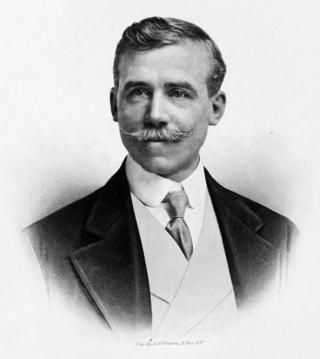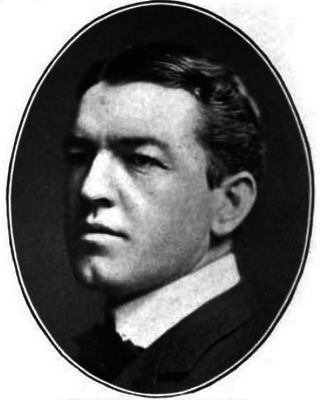
The Winton Motor Carriage Company was a pioneer United States automobile manufacturer based in Cleveland, Ohio. Winton was one of the first American companies to sell a motor car. In 1912 Winton became one of the first American manufacturers of diesel engines.
George Baldwin Selden was an American patent lawyer and inventor from New York who was granted a U.S. patent for an automobile in 1895.

An antique car is an automobile that is an antique. Narrower definitions vary based on how old a car must be to qualify. The Antique Automobile Club of America defines an antique car as over 25 years of age. However, the legal definitions for the purpose of antique vehicle registration vary widely. The antique car era includes the Veteran era, the Brass era, and the Vintage era, which range from the beginning of the automobile up to the 1930s. Later cars are often described as classic cars. In original or originally restored condition antiques are very valuable and are usually either protected and stored or exhibited in car shows but are very rarely driven.

The Brass Era is an American term for the early period of automotive manufacturing, named for the prominent brass fittings used during this time for such features as lights and radiators. It is generally considered to encompass 1896 through 1915, a time when cars were often referred to as horseless carriages.

Albert Augustus Pope was a Brevet Lieutenant-Colonel in the Union Army. He was an importer, promoter, and manufacturer of bicycles, and a manufacturer of automobiles.
Smith & Mabley was an American veteran era importer of European automobiles and produced the American C. G. V. automobile in 1902, and the S & M Simplex automobile from 1904 to 1907, in New York City.

Development of the automobile started in 1672 with the invention of the first steam-powered vehicle, which led to the creation of the first steam-powered automobile capable of human transportation, built by Nicolas-Joseph Cugnot in 1769. Inventors began to branch out at the start of the 19th century, creating the de Rivas engine, one of the first internal combustion engines, and an early electric motor. Samuel Brown later tested the first industrially applied internal combustion engine in 1826.

Electric Vehicle Company was an American automobile holding company and early pioneering manufacturer of automobiles.

A high wheeler is a car which uses large diameter wheels that are similar to those used by horse-drawn vehicles. These cars were produced until about 1915, predominantly in the United States.

Alexander Winton was a Scottish-American bicycle, automobile, and diesel engine designer and inventor, as well as a businessman and racecar driver. Winton founded the Winton Motor Carriage Company in 1897 in Cleveland, Ohio, making the city an important hub of early automotive manufacturing. His pioneering achievements in the automotive industry included taking one of the first long-distance journeys in America by car and developing one of the first commercial diesel engines. Winton left the automotive manufacturing business when he liquidated his car company in 1924 to focus on his powertrain engineering firm, Winton Gas Engine & Mfg. Co., which he had established twelve years earlier to focus on engine development. This business was sold to General Motors in 1930 and became the Cleveland Diesel Engine Division. Winton died in 1932 and is interred in Lake View Cemetery in Cleveland.

Charles Merrill Hough was a United States circuit judge of the United States Court of Appeals for the Second Circuit and previously was a United States District Judge of the United States District Court for the Southern District of New York.

The Selden Motor Vehicle Company was a Brass Era American manufacturer of automobiles. The company, founded in 1906, was based in Rochester, New York, and built automobiles from 1907 to 1914 and trucks from 1913 to 1932.

A car or automobile is a motor vehicle with wheels. Most definitions of cars say that they run primarily on roads, seat one to eight people, have four wheels, and mainly transport people.

The Russell Motor Car Company was an automobile manufacturer in Toronto, Canada, that produced cars from 1904 to 1916. The company is considered to have produced Canada's first successful automobile.

The automotive industry in the United States began in the 1890s and, as a result of the size of the domestic market and the use of mass production, rapidly evolved into the largest in the world. The United States was the first country in the world to have a mass market for vehicle production and sales and is a pioneer of the automotive industry and mass market production process. During the course of the 20th century global competitors emerged especially in the second half of the century primarily across European and Asian markets, such as Germany, France, Italy, Japan and South Korea. The U.S. is currently second among the largest manufacturer(s) in the world by volume.
The Automobile Manufacturers Association was a trade group of automobile manufacturers that operated under various names in the United States from 1911 to 1999. It was replaced by the Alliance of Automobile Manufacturers.

Frederic Latta Smith was a pioneer of the automobile business. He was one of the founders of the Olds Motor Works in 1899 and of General Motors Corporation in 1908. He was also the president of the Association of Licensed Automobile Manufacturers in its early years.

The automotive industry in Sweden is mainly associated with passenger car manufacturers Volvo Cars and Saab Automobile but Sweden is also home of two of the largest truck manufacturers in the world: AB Volvo and Scania AB. The automotive industry is heavily dependent on export as some 85 percent of the passenger cars and 95 percent of the heavy vehicles are sold outside of Sweden. The automotive industry and its sub-contractors is a major part of Swedish industry. In 2011 around 110,000 people were employed and the export income of 150 billion SEK accounted for 12 per cent of Sweden's export income. During 2009 128,738 passenger cars and 27,698 heavy vehicles were built in Sweden. Koenigsegg is also a famous swedish company which makes some of the fastest cars in the world, but also some of the most expensive. They make cars like:Koenigsegg Jesko, Gemera, 1:One, Agera, Regera etc.
Flint Wagon Works of Flint, Michigan, manufactured wagons from the early 1880s. One of the world's most successful horse-drawn vehicle makers they formed with their Flint neighbours a core of the American automobile industry. In 1905 Flint was promoting itself as Flint the Vehicle City. The former site is now located in the neighborhood of Flint known as "Carriagetown".
















